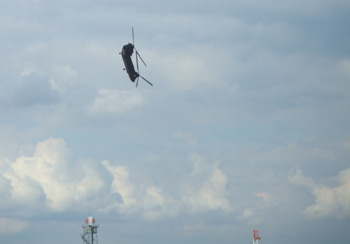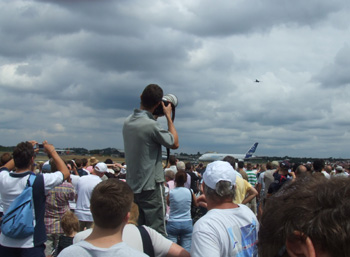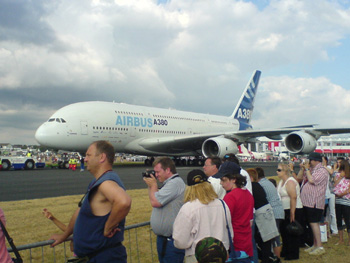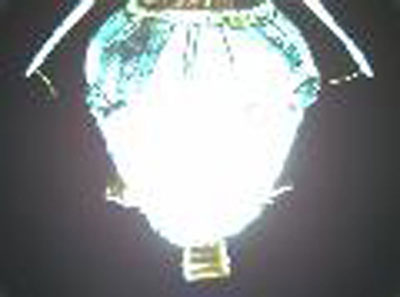We are developing the social individualist meta-context for the future. From the very serious to the extremely frivolous... lets see what is on the mind of the Samizdata people.
Samizdata, derived from Samizdat /n. - a system of clandestine publication of banned literature in the USSR [Russ.,= self-publishing house]
|
Jeff Bezos of Amazon fame is moving his spaceship company, Blue Origin, forward through the high hurdles race called government regulations.
The Blue Origin craft is slated to fly regularly by 2010. While this is indeed an aggressive schedule, I find it more reasonable now that I know a bit about the spaceship. It is the next step in development of the McDonnell-Douglas DCX. The test article for this was built and flown at White Sands for under $60M in under two years by Dr. Gaubatz and his team in the early to mid nineties. Takeoffs required a ground crew of less than a dozen people and they were perhaps the first to ever fly a Vertical Takeoff/Vertical Landing craft or “A spacehip like God and Robert Hienlein intended”, as one pundit put it, multiple times in a day. They also proved DCX could carry out a safe emergency landing after a major problem on takeoff and proved out the flight software for the complex flipover maneuver to rotate from pointy end first flight to ass end first for landing.
For those interested in such things, the McDonnell-Douglas master control console inside the single control van on site was… an Apple computer.
I am now wondering if Blue Origin will show up at Las Cruces this fall to compete for the NASA moon lander technology challenge prize I wrote of a few months ago. The beauty of a VTVL spacehsip is it works anywhere, whereas spaceplanes are rather limited in their choice of landing worlds. I know Dr. Gaubatz is going to be there and if they do, I am sure he will shed a tear of grandfatherly pride.
Hot Jets and Good Luck to Blue Origin!
There are a bunch more photos from inside the Genesis 1 space station prototype with all sorts of fun stuff floating about. I would have loved to have been sitting in the meeting where they came up with the idea of flying a container full of Mexican Jumping Beans!
The external shot is also far clearer then the post-launch quick look shot I posted a week or so ago.
I suppose one of the main reasons that airshows are held is that actually seeing the thing fly can temporarily remove the sense from people who in their rational moments think that an A380 or some other aircraft may not have much of a practical role, or may not be worth the money.
And as it happened, on Sunday, I was impressed by the A380, and I was again impressed by the V22 Osprey, which if nothing else can certainly put on an impressive display.

Alas, I didn’t get a good picture of it in “aeroplane mode”, but for a helicopter it was certainly quick in getting from A to B. This is the best I can do.

On the other hand, it is quite impressive what a proven, useful, and big helicopter can do when it only has the tiny fuel load needed for a ten minute display.

It was something of a day for the helicopters. As well as the Chinook, the RAF sent a Merlin for an aerobatic display, and this was also really impressive. Of course, there were lots and lots of jet fighters, too (the highlight of which was probably a MiG-29), but in order for photos of them to not look like a black spot in the distance, you really need a lens like this one, which I did not have.

Still, I am sure Brian will give me points for the billion monkeys shot.
If you have just purchased your trip to Space Station Alpha from Space Adventures for $20M and still have money burning a hole in your pocket, you can now take a walk in space for a mere $15M extra.
According to Astronaut Tom Jones:
During a 90-minute EVA, which is the time it takes the ISS to make one complete orbit around Earth, a spacewalker would experience orbital sunrise and sunset, Jones said.
“That 90 minutes is like gold to a real spacewalkers,” Jones said. “I got a total of five or 10 minutes of doing that in my 19 hours in terms of just unstructured time, so it’s literally that precious an experience.”
Now if my next venture works out and makes me a billionaire…
You simply have to look at this if you are into unaffordable jet aircraft!

Although I have had some doubts about the financial case for the A380, it is none the less awfully impressive when you see it from up close.

(Farnborough 2006 was splendid. More later).
You simply have to watch this if you are into affordable jet aircraft!
One way or the other, we will see the private flying transport before the end of this century. Materials and information technology advances have brought the idea to the edge of viability and this venture between Bell and an Israeli company might just be enough to push it over the edge.
On Monday at the Farnborough International Airshow, Bell Helicopter announced that it will team with an Israeli company to develop a futuristic aircraft that would allow soldiers and police far greater mobility in cities.
The X-Hawk, as envisioned by Bell, could hold a pilot and up to 11 troops. It could navigate congested urban areas by flying above narrow streets and between closely spaced buildings.
Propelled by two jet turbine engines that would drive pusher propellers and downward-thrust lift fans, similar to those on the short-takeoff-vertical-landing version of the F-35 Lightning II, the X-Hawk could operate in spaces far more confined than a helicopter can.
If they do not do it, someone else will. There are multiple ‘flying car’ projects out there and someday someone will cross the threshold into commercial viability.
Ed:Thank reader Steven Peterson for pointing us to this article
The MV-22 Osprey programme has survived so many fatal crashes and attempts to kill it in congress that perhaps it should be renamed the MV-22 ‘Rasputin’. Yet still it continues, though I see that one of the two MV-22s flown from the US to Farnborough a couple days ago had to divert to Iceland because of engine difficulties.
Yet every time I look at the amazing disc loading on those things, I wonder how the hell they intend to use them? Given that when hovering the downwash has been known to knock people off their feet and send fast moving debris flying in all directions, how is this kite going to replace the CH-46E and CH-53D? An aircraft designed for unprepared LZ special operations that has to hover high to avoid downwash related problems and which cannot auto-rotate if damaged fills me with grave foreboding. Although the range and speed are very impressive, I wonder if this aircraft will not just be too hot and too inflexible for practical operations at the current state of technology.
The Farnborough Air Show is on near London this week. In the commercial jet market, things have changed dramatically since the Paris Air show last year. A year ago Airbus had their first flying displays of their very large new A380 airliner, and for the fifth year in a row Airbus received more orders for airliners than did Boeing. Through a combination of more modern aircraft, more modern production lines and (perhaps) state subsidies, Airbus has come from a distant position in the market to market leadership.
However, this year Airbus fallen to a distant second in the market, having received only 117 orders this year to Boeing’s 480. The A380 is behind schedule, the first airlines to receive it will be getting it six months late, and Airbus has scarcely received an order for it in the last couple of years. (Total orders are presently for 159). Boeong has received orders for 400 of its new mid-market 787 aircraft (and orders for Airbus’ A330 and smaller A340 variants have dried up completely) and is also significantly ahead of Airbus in the upper mid-market segment containing Airbus’ A340-600 aircraft and Boeing’s 777-300. Airbus’ British shareholder BAe Systems would like to sell its minority stake in Airbus, and therefore recently commissioned N. M. Rothschild to provide a valuation of the stake. The resulting valuation (€2.75bn) was dramatically less than the (€4bn) BAe Systems had anticipated.
The short term reasons for this turnaround are fairly obvious. The dollar has weakened significantly compared to the euro. While Airbus has hedged its currency exposure on existing orders and these will therefore still be profitable, it lacks this advantage going forward on new orders. While Boeing’s production methods were outdated five years ago, its logistical systems have been dramatically improved since, and in terms of production it once again can compete. The A380 delay is certainly a short term factor, but most aircraft programs feature a delay like this at some point.
But these are only the short term reasons. There are more long term reasons, but the financial press seems to have failed to put the whole story together. → Continue reading: Airbus misses a paradigm shift
Bob Bigelow has released his first baby picture.
The Genesis 1 space station test article is working so flawlessly the Bigelow crew is wandering about with glazed eyes or collapsing to recover from long weeks of sleep deprivation.
The module unwound and inflated to its full 8 foot diameter, the solar panels are delivering power and they are receiving more telemetry data than they can handle.
 Photo: Bigelow Aerospace Photo: Bigelow Aerospace
Bob Bigelow’s one third scale inflatable space station is in orbit after a launch from Russia. This is the first of several unmanned test articles which will lead to a full scale station by 2015. Even so, at 8 feet in diameter and 14 feet in length when inflated, this habitat is not exactly small.
You can read a bit more about it at CNN. I would also recommend checking space.com and the other usual suspects for more detailed accounts, something I am about to do myself.
Mr Phelps:
Your mission, should you choose to accept it, is to explore an ultra-secret North Korean missile launch facility located several kilometers inland from a section of due south facing coastline not far from the Chinese border. There is a small town about 1-2km south of the pad, directly under the most probable launch trajectory. A mad ruler is thought to be building nuclear capable ICBM’s at this site. We do not believe their technological level makes them capable of success at the task at present, so we recommend you do not use the town as a base of operations.
Find the various facilities and report back to us. Should you be captured or your computer be eaten by starving North Korean peasants, Samizdata will disavow all knowledge of your existence.
Your targets may be found near N40°51’17” E129°39’58” via http://maps.google.co.uk/ at the 50 meter per 2.5 centimeter scale.
Good luck and good hunting.
|
Who Are We? The Samizdata people are a bunch of sinister and heavily armed globalist illuminati who seek to infect the entire world with the values of personal liberty and several property. Amongst our many crimes is a sense of humour and the intermittent use of British spelling.
We are also a varied group made up of social individualists, classical liberals, whigs, libertarians, extropians, futurists, ‘Porcupines’, Karl Popper fetishists, recovering neo-conservatives, crazed Ayn Rand worshipers, over-caffeinated Virginia Postrel devotees, witty Frédéric Bastiat wannabes, cypherpunks, minarchists, kritarchists and wild-eyed anarcho-capitalists from Britain, North America, Australia and Europe.
|










